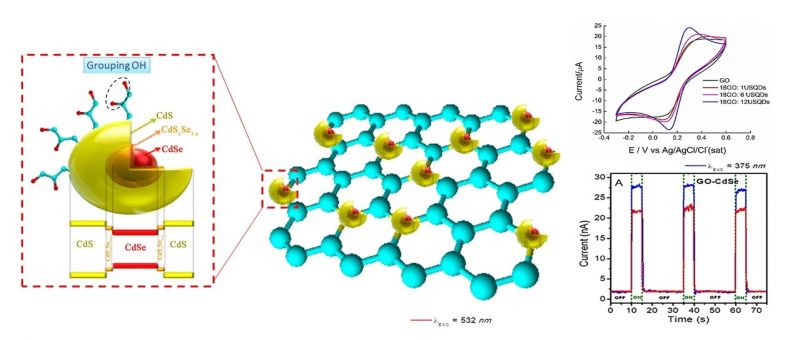Nowadays, new functional materials of very small dimensions are welcome to face the interest in increasingly smaller and better performing devices. Even more so if their properties can be refined to meet the needs of each application.
A Brazilian scientific team developed a nanocomposite consisting of two-dimensional sheets of reduced graphene oxide (rGO) and ultra-small quantum dots, and found a way to adjust its electrical and optical properties, taking advantage of the synergy between both components. The discovery brings possibilities for using this nanomaterial in the development of more sensitive devices with new features, for areas like energy and health.
“With the surprising and innovative results of this work, the development of new nanocomposites emerges, aimed at training human resources and with wide applicability of the technology,” says Professor Noelio Oliveira Dantas (UFAL and UFU), corresponding author of the article who reports the finding in The Journal of Physical Chemistry C.
From Minas to Alagoas
The research began in 2016 in the Brasilian state of Minas Gerais, at the Federal University of Uberlândia (UFU), within the PhD of Rosinildo Fideles do Nascimento, under the guidance of professors Noelio Dantas and Anielle Christine Almeida Silva, researchers with vast experience in new nanostructured materials, including relevant contributions to the synthesis of quantum dots.
At the Institute of Physics of UFU, more precisely at the Laboratory of New Insulating and Semiconductor Materials, reduced graphene oxide (a graphene derivative that has been widely used in and outside academia) and ultra-small quantum dots (particles of less than 5 nm with unique optical and electronic properties, due to the quantum phenomena that occur at this dimensional scale) were synthesized and characterized. A good conductor of electricity, reduced graphene oxide, however, does not have a semiconductor behavior. On the other hand, the large surface area of two-dimensional sheets of rGO can homogeneously accommodate good amounts of semiconductor particles, such as quantum dots.
But going back to the history of this work, the researchers prepared quantum dots composed of a core of cadmium selenide (CdSe) of about 1.5 nm and a shell of cadmium sulfide (CdS) of less than 1 nm. The next step was carried out in Alagoas. In fact, in 2018, professors Noelio and Anielle were transferred to the federal university of that state, UFAL, where they created the Laboratory of New Nanostructured and Functional Materials. At UFAL, Rosinildo and his advisors used the nanomaterials prepared there to develop the nanocomposite.
In order to investigate the effect of the concentration of quantum dots on the optical and electrical properties of the nanocomposite, they produced and characterized four versions of the material, each with a specific proportion of rGO and quantum dots. The nanocomposites were obtained using a method that activates groups of atoms that are present in rGO (carboxyls) and predisposes them to interact with groups in the shells of quantum dots (hydroxyls). At the end of the process, the two components are strongly bonded through the sharing of pairs of electrons (covalent bond), forming the nanocomposite.

Synergy between nanomaterials
After synthesizing the materials, the researchers used the infrastructure available at three laboratories of the Institute of Physics at UFAL to experimentally investigate the influence of the concentration of quantum dots on the properties of the nanocomposites. This part of the work involved the collaboration of professors, doctoral students and a postdoc from four university research groups.
Based on the results of this collaborative study, Rosinildo and his advisors confirmed that, in the nanocomposite, quantum dots transfer charge carriers (electrons and holes) to the rGO. However, the main contribution of the study was to demonstrate that the rate of this transfer of charge carriers can be adjusted by increasing or decreasing the concentration of quantum dots in the material.
“With the appropriate concentration of quantum dots, we have a greater electrical response of the nanocomposite, enabling to develop new, more sensitive and functional devices,” highlights Professor Anielle Christine Almeida Silva, who is also corresponding author of the paper.
Applications
By illuminating the nanocomposite with a suitable radiation, the quantum dots absorb light, which excites and mobilizes their charge carriers, which are transferred to the rGO. The effect stops when the light is removed. With these characteristics, one of the most distinct applications of the nanocomposite is in quantum dot solar cells. In these devices, which are still experimental but whose efficiency has increased yearly, quantum dots that absorb radiation in the solar light range are used. The high transfer of loads to the rGO is, in this case, a differential.
However, other uses are also promising. Professors Noelio Dantas and Anielle Christine Almeida Silva count on the collaboration of researchers specialized in the development of sensors and biomedical applications. “We are concluding new works that demonstrate the excellent potential of these nanocomposites in improving the electrical response in sensors, as well as their biocompatibility and the development of new theranostic tools,” reveals professor Anielle Christine Almeida Silva. Theranostic platforms are systems, usually nanometric, capable of diagnosing, treating and monitoring health problems.
“The use of these nanocomposites is enormous, from technological applications (solar energy, sensors) to nanobiotechnological applications (biological sensors, theranostic tools),” says Professor Noelio Dantas. According to this researcher “Brazil needs to invest in research that directly contributes to the development of technology, as well as creating programs that bring together and encourage partnerships between companies and researchers.”

Paper: Tuning the Optical and Electrical Properties of rGO-CdSe/CdS Ultrasmall Quantum Dot Nanocomposites. Rosinildo Fideles do Nascimento, Anielle Christine Almeida Silva, Tasso O. Sales, Artur F. Sonsin, Eduardo Jorge da Silva Fonseca, Samuel T. Souza, Ygor M. de Oliveira, Fabiane C. de Abreu, and Noelio Oliveira Dantas. The Journal of Physical Chemistry C 2021 125 (12), 6805-6811. https://doi.org/10.1021/acs.jpcc.0c09813
Contacts: Profa Anielle Christine Almeida Silva – acalmeida@fis.ufal.br. Prof. Noelio Oliveira Dantas – noelio@fis.ufal.br.

Marilia Oliveira Fonseca Goulart
Parabéns! Trabalho relevante e com excelente potencial!